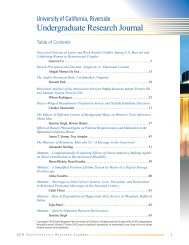2010 - Undergraduate Research, Scholarship and Creative Activity
2010 - Undergraduate Research, Scholarship and Creative Activity
2010 - Undergraduate Research, Scholarship and Creative Activity
Create successful ePaper yourself
Turn your PDF publications into a flip-book with our unique Google optimized e-Paper software.
depression <strong>and</strong> anxiety symptomology. We<br />
found that increased concern with an accent<br />
significantly relates to increased levels of<br />
psychological maladjustment. Because linguistic<br />
accent <strong>and</strong> psychological maladjustment are<br />
related, linguistic accent is an important topic to<br />
study <strong>and</strong> desires greater attention in both<br />
research <strong>and</strong> practice.<br />
Maintaining Inflorescent Meristem Identity<br />
in Arabidopsis<br />
Nolan Ung, Botany <strong>and</strong> Plant Sciences<br />
Mentor: Harley Smith<br />
Department of Botany <strong>and</strong> Plant Sciences<br />
In order for a plant to complete its lifecycle, it<br />
must transition from a leaf bearing vegetative<br />
phase to the flower producing phase. Genomic<br />
studies performed in Arabidopsis, demonstrate<br />
that the commitment to flowering requires a<br />
change in the transcriptome of the shoot apical<br />
meristem. During the floral transition, genes<br />
that promote vegetative identity must be<br />
repressed, while genes that induce flowering<br />
must be activated. To date, the molecular<br />
mechanisms that orchestrate these changes in<br />
gene expression profiles are poorly understood.<br />
We recently discovered that the homeobox<br />
transcription factor SHOOTMERISTEMLESS<br />
(STM), which is essential for meristem<br />
maintenance, functions with inflorescence<br />
identity MADS-box complex, AGAMOUS-<br />
LIKE24 (AGL24) -SURPRESSOR OF<br />
OVEREXPRESSION OF CONSTANS1<br />
(SOC1), to initiate flower meristems on the<br />
flanks of the SAM. To further underst<strong>and</strong> the<br />
interplay between STM <strong>and</strong> the AGL24-<br />
SOC1the floral transition, we utilized a genetic<br />
approach. While mutations in stm, agl24 <strong>and</strong><br />
soc1 maintain inflorescence identity, the stm<br />
soc1 reproductive shoots revert to a vegetative<br />
mode of growth after bolting. After undergoing<br />
many cycles of inflorescence reversion, the stm<br />
soc1 reproductive shoots will eventually flower.<br />
Preliminary studies indicate that the<br />
inflorescence reversion phenotype is enhanced<br />
in stm soc1 agl24 triple mutants such that these<br />
shoot never flower, producing inflorescences<br />
with aerial rosettes. Based on our genetic<br />
studies, we propose that STM functions with<br />
AGL24-SOC1 to repress vegetative identity<br />
during inflorescence development. We are<br />
currently determining whether the interplay<br />
between STM <strong>and</strong> AGL24-SOC1 functions to<br />
repress vegetative identity genes during<br />
inflorescence development.<br />
Race: The Missing Link in Judith Butler’s<br />
Gender Trouble <strong>and</strong> Its Significance in the<br />
Politics of Gender Subversion<br />
Cheri Veilleux, English/ Women‘s Studies<br />
Mentor: Caroline Tushabe<br />
Department of Women‘s Studies<br />
Judith Butler‘s Gender Trouble is one of the<br />
milestones in feminist theory, specifically on the<br />
concept of gender subversion. In this text Butler<br />
focuses on select critical feminists who propose<br />
ways to subvert gender. One key argument of<br />
Butler‘s is in reference to feminist philosopher<br />
Monique Wittig‘s notion of lesbian subversion<br />
of gender woman. Wittig argues that though it<br />
is true that every person is sexed, <strong>and</strong> therefore<br />
gendered, lesbian identity defies woman identity<br />
because woman identity can only exist in an<br />
oppositional relationship to man. Wittig draws a<br />
reader‘s attention to juridical law <strong>and</strong> its<br />
language in relation to gender identity. Read in<br />
this way, on the one h<strong>and</strong>, Butler finds Wittig to<br />
offer lesbian identity as a category that<br />
successfully subverts normative woman identity<br />
within the politics of gender. On the other h<strong>and</strong>,<br />
Butler views Wittig‘s premise as controversial<br />
<strong>and</strong> points out several problematic aspects<br />
within Wittig‘s argument: Wittig reinforces the<br />
universal man <strong>and</strong> the notion of compulsory<br />
heterosexuality as already established under<br />
juridical law. Both Butler <strong>and</strong> Wittig speak of<br />
monolithic woman <strong>and</strong> fail to account for raced<br />
women <strong>and</strong> their politics of gender subversion, a<br />
point this paper will argue. Drawing on works<br />
by Oyeronke Oyewumi <strong>and</strong> John Wood, I will<br />
offer a different feminist lens through which<br />
woman identity can be inclusive of other<br />
identities in feminist politics of liberation<br />
without privileging sexual identity like lesbian<br />
identity.<br />
Fourth Annual UCR Symposium for <strong>Undergraduate</strong> <strong>Research</strong>, <strong>Scholarship</strong> <strong>and</strong> <strong>Creative</strong> <strong>Activity</strong><br />
46














